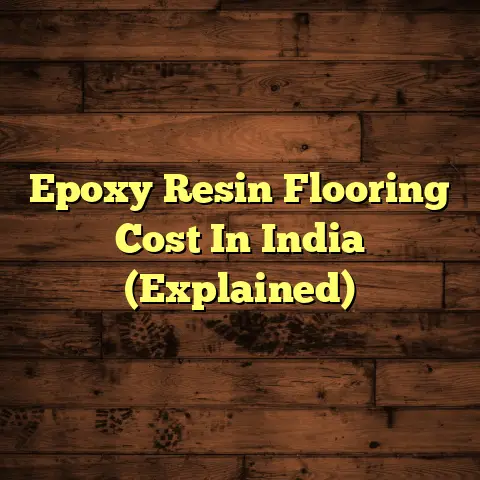Understanding The Cost Differences In Flooring Materials? (Explained)
Setting a goal for this article, I want to help you understand the cost differences in flooring materials. With my years of experience as a flooring contractor, I’ll share personal stories, insights, and tips that can make a real difference in your flooring projects.
As a contractor, I’ve faced countless decisions regarding flooring types and their associated costs. Through trial and error, I’ve gained valuable insights that I’m excited to share with you. Flooring is one of the most significant investments you can make in a home, so understanding the nuances can lead to better choices and ultimately enhance your living space.
The Cost Spectrum of Flooring Materials
When I first started in flooring, I was often surprised by how much the costs could vary from one material to another. The choices can be overwhelming, and I’ve learned that understanding these differences can save you both time and money.
Wood Flooring: Luxurious Yet Costly
I remember my first hardwood flooring job in a beautiful old Victorian home. The client had her heart set on oak, and I could see why. The warm tones and natural grain patterns were stunning. However, the cost was a significant factor. Solid oak wood can range from $5 to $10 per square foot, depending on the quality.
In contrast, engineered hardwood, which I also use, is a more budget-friendly option. It mimics the look of solid wood but is usually priced between $3 and $8 per square foot.
The installation process is similar, but with engineered wood, you often have more flexibility when it comes to temperature changes and moisture levels.
I recall when I installed engineered hardwood in a basement that was prone to humidity. The client wanted the elegance of wood without worrying about warping or buckling over time. The engineered option fit perfectly into the space and budget while providing the aesthetic they desired.
Laminate Flooring: The Budget-Friendly Option
On another project, I had a client who wanted a hardwood look without breaking the bank. That’s when I introduced them to laminate flooring. This material can cost between $1 to $4 per square foot.
I was impressed by how realistic it looked once installed. However, I did face a few challenges with laminate—like getting the seams perfectly aligned. But with patience and the right tools, it turned out great!
Laminate has come a long way in terms of quality and aesthetics. On one occasion, I installed a high-quality laminate in a busy family home where kids were constantly running around. The durability was fantastic, and it held up against scratches and spills much better than I expected. If you’re going for a quick installation and a low cost, laminate is definitely worth considering.
Tile: Durable But Pricey
Tiles offer another avenue to explore. They can be beautiful and durable but come with their own set of costs.
Ceramic tiles can range from $1 to $10 per square foot, while porcelain tiles can start at around $3 and go up to $15 or more.
I had a client who wanted an intricate tile design for her kitchen backsplash. The tile itself was reasonably priced at about $5 per square foot, but once we factored in the labor for the detailed installation, the overall costs added up quickly.
In another project, we used large format tiles for a modern bathroom renovation. The tiles were stunning but required precise cutting and leveling during installation. This complexity increased labor costs, which clients often overlook when budgeting for tile work.
Concrete: A Unique Choice
Concrete flooring is another option I’ve worked with. It’s not just for garages anymore! Polished concrete can be quite striking and usually costs between $2 to $6 per square foot.
I once helped a local café owner transform his space with polished concrete. The installation process was labor-intensive, but the results were stunning—plus, it was easy to maintain.
However, one challenge I encountered was dealing with cracks that appeared after installation due to settling. It’s essential to ensure proper curing and finishing techniques to minimize this risk.
Factors Influencing Costs
While I’ve shared some of the basic costs of different flooring materials, there are several factors that influence these prices:
- Location: In urban areas like New York or San Francisco, labor rates are significantly higher than in rural areas.
- Quality: Higher quality materials often come with higher costs due to manufacturing processes.
- Installation Complexity: Some materials require specialized skills for installation, which can increase labor costs.
For example, when installing intricate tile designs or polished concrete finishes, you may need to hire specialized contractors who charge higher rates than standard installers.
Another factor to consider is market fluctuations; sometimes prices can jump unexpectedly based on supply chain issues or demand spikes.
Using FloorTally for Accurate Estimates
One tool that has been invaluable in my work is FloorTally. This platform helps me generate accurate cost estimates based on local material and labor rates. It saves me hours of back-and-forth with clients over budgets.
For instance, when discussing options for a recent project, I used FloorTally to show my client the breakdown of costs for different materials—this transparency helped us agree on a budget that made sense for both of us.
What’s great about FloorTally is that it allows me to input specific details about the project—like room dimensions and material preferences—so I can provide tailored estimates that reflect real-world costs.
Hidden Costs to Consider
When planning a flooring project, it’s crucial to account for hidden costs that can sneak up on you:
- Underlayment: Depending on the material you choose, underlayment can add an extra $0.50 to $2.00 per square foot.
- Removal of Old Flooring: If you need to remove old flooring before installing new, this can easily add $1 to $3 per square foot.
- Maintenance Costs: Some materials require more upkeep than others. For example, hardwood may need periodic refinishing, while laminate is generally low-maintenance.
I once worked on a project where the client was surprised by how much removing old carpet added to their budget. It’s always best to discuss these potential costs upfront to avoid any unexpected surprises later.
Comparing Choices: My Recommendations
When deciding on flooring materials, consider your needs:
- If you’re looking for luxury: Go with solid hardwood. Just be prepared for the higher cost.
- For budget-conscious projects: Laminate offers a great look at a fraction of the price.
- If durability is key: Consider tile or polished concrete.
Each option has its unique advantages and challenges, so weigh them carefully based on your specific situation.
Real-Life Anecdotes
I recall a project where we installed high-end vinyl plank flooring for a family home. It looked fantastic and was incredibly easy to maintain. However, I learned the hard way that not all vinyl is created equal; some cheaper options didn’t hold up well under heavy foot traffic.
Conversely, I’ve had clients who splurged on exotic hardwood only to find it wasn’t suitable for their environment—too much moisture led to warping. These experiences taught me to always consider location and use when recommending materials.
I had another experience where I installed bamboo flooring for an environmentally conscious client. While bamboo is often marketed as a sustainable choice, not all bamboo products are created equal. We had to source high-quality bamboo from reputable suppliers to ensure durability and longevity. The cost was higher than expected, but my client appreciated knowing they were making an eco-friendly choice.
Practical Tips for Installation
- Always acclimate materials: For wood products, letting them adjust to room temperature prevents issues later.
- Invest in quality underlayment: It can enhance comfort and prolong the life of your flooring.
- Plan for waste: I usually estimate around 10% extra material to account for cuts and mistakes.
- Seek professional help for complex installations: Some materials require expertise that can save you time and headaches.
- Measure twice, cut once: This old adage rings true in flooring installation; taking precise measurements helps avoid costly mistakes.
- Use proper tools: Having the right tools for each type of flooring material makes a world of difference in both efficiency and quality.
- Consult with suppliers: They often have valuable insights into trends and best practices that can affect your decision-making process.
- Consider future needs: Think about how your flooring choice will hold up over time, especially if you plan on living in your home long-term.
Maintenance Matters
Different flooring materials come with various maintenance requirements:
- Hardwood: Regular cleaning and occasional refinishing keep it looking great.
- Laminate: Simple sweeping and mopping will do the trick.
- Tile: Grout lines need regular cleaning to prevent staining.
On one occasion, I had a homeowner who neglected their hardwood floors because they thought they could get away with minimal maintenance. After several years, we had to sand down and refinish them—an expensive but necessary process!
With laminate, I’ve found that many homeowners underestimate how easy it is to keep clean; a simple weekly sweep followed by a damp mop works wonders without damaging the surface.
Installation Techniques: A Closer Look
Each flooring type comes with its methods of installation:
Hardwood Installation
When installing hardwood flooring, there are typically three methods: nail-down, glue-down, or floating installation.
- Nail-down is common in solid wood applications where subfloors are made of plywood or OSB.
- Glue-down works well with engineered wood but requires precise application for optimal results.
- Floating installations are versatile and often used with engineered products or laminate.
I once encountered an issue with nail-down installations when we realized the subfloor wasn’t level enough; this led us to use additional underlayment layers to ensure stability.
Laminate Installation
Installing laminate is generally easier than hardwood due to its click-lock system that allows pieces to interlock without glue or nails.
However, it’s crucial to follow manufacturer instructions closely—one project taught me not all laminate is created equal! Some brands require extra care during installation due to variations in thickness or locking mechanisms.
Tile Installation
Tile installation involves measuring carefully and ensuring even spacing between tiles using spacers during the process.
One time I learned firsthand how important proper leveling is; we had to lift tiles out after realizing they were slightly uneven—a frustrating but necessary step!
Concrete Installation
Polished concrete requires meticulous preparation of the surface before pouring; any imperfections will show through once finished.
I always make sure clients understand the importance of curing times—rushing this step can lead to unsightly cracking down the line.
Understanding Flooring Terminology
As we navigate through different types of flooring materials and their installation processes, it’s essential to familiarize yourself with some common terminology that might come up:
- Subfloor: The base layer beneath your flooring material.
- Underlayment: A layer between the subfloor and finished floor that provides cushioning and soundproofing.
- Moisture Barrier: Essential in areas prone to humidity (like basements) to prevent damage from moisture seeping up through floors.
- Plank Width: Refers to how wide each individual piece of flooring is; wider planks generally lend a more modern aesthetic.
Understanding these terms will not only help you communicate more effectively with contractors but also empower you during discussions about your project.
Evaluating Long-Term Costs
When evaluating flooring options, consider not just the initial investment but also long-term costs associated with maintenance and potential replacement:
- Hardwood may require refinishing every few years, which adds up over time.
- Laminate tends to last longer without needing replacement, making it ideal for high-traffic areas where wear might be an issue.
- Tile might last indefinitely if properly maintained but requires grout upkeep that can become tedious over time.
I’ve often seen clients focus solely on upfront costs without factoring in these long-term implications; this kind of oversight can lead them down an expensive path later on!
Eco-Friendly Flooring Options
With increasing awareness around sustainability, many homeowners are looking for eco-friendly flooring choices:
- Bamboo is considered sustainable because it grows quickly compared to traditional hardwoods.
- Cork is another great option derived from tree bark; it’s renewable and provides natural insulation.
- Reclaimed wood not only reduces waste but also adds character and history to your space.
However, it’s essential to ensure these products are sourced responsibly; I’ve encountered situations where eco-friendly labels didn’t match actual practices—always ask questions!
Final Thoughts
As you weigh your options, remember that each material has its costs and benefits. The key is matching your choice with your budget and lifestyle needs. With the insights I’ve shared from my experiences in flooring—both good and bad—I hope you feel more equipped to make informed decisions.
Whether you’re tackling a DIY project or hiring professionals, understanding these cost differences will guide you through the process smoothly. So what are you waiting for? Your perfect floor awaits!





